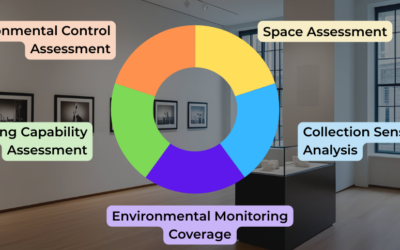Storing books requires careful consideration of several environmental factors. Book storage temperature has an interesting relationship to conservation goals, which is mostly (although not entirely) due to how temperature and relative humidity relate to each other. Let’s explore some basic questions so you may evaluate how you should think about temperature in the context of book storage.
Why is book storage temperature important?
Maintaining an appropriate book storage temperature is crucial for the long-term preservation of books. Paper and binding materials can degrade over time, and this process is accelerated when books are stored at high temperatures due to the acceleration of chemical reactions at higher temperatures (Check out this explanation if you’re not afraid of chemistry!).
Higher temperatures can cause acid hydrolysis and oxidation reactions in the paper and binding materials to speed up, leading to embrittlement and discoloration. They can also accelerate the growth of mold and other biological agents that may harm books. Low temperatures can increase your relative humidity and lead to actual condensation on your books, eventually leading to mold growth and staining.
Different insect and rodent pests also thrive at varying temperatures, so that if your book storage environment is friendly to them, they are more likely to reproduce and cause a serious infestation.
If you think about the direct relationship between temperature and humidity, temperature swings will also affect the relative humidity in your spaces, making it likely that you may become too dry or too damp even without any moisture coming in and out of your spaces. If you would like to learn a bit more about this relationship, don’t miss Angelica Isa’s thorough article on understanding psychrometric charts and dew points.
What is the ideal temperature for storing books?
The ideal book storage temperature largely depends on the specific type of book and its material composition. Not all books were created equal.
Among other things, you should consider the following variables when it comes to storage:
- The type of substrate (is it paper? If so, which kind of paper? Is it parchment?)
- The type of binding (is it leather, paper, plastic, or something else?)
- Are there other additional materials (wax seals? Acrylic paints on paper? Things that could peel off or melt?)
Make sure to note the Canadian Conservation Institute’s Notes on Incorrect Temperature to choose the right temperature for your type of material components.
Lower temperatures can be beneficial for slowing the rate of chemical degradation, but they may also increase the risk of condensation if not managed properly (See the dew point article again). Additionally, it’s important to remember that extreme temperature fluctuations should be avoided, as they can stress the materials and lead to physical damage such as softening of waxes or embrittlement of paint media. These extremes should be very rare occurrences and you should not normally need to be worried about them.
Once you have separated out your special items which will require separate temperatures or environmental conditions for storage, a general guideline number for book storage temperature can be 64-72°F (18-22°C) or “room temperature or below”. Make sure that your set temperature is not affecting your relative humidity levels to the point where you could overdry the books or open the way for mold growth.
If you would like to learn more about environmental standards and the history of their recommendations in conservation, don’t miss that chapter in our Definitive Guide to Environmental Monitoring for Collections or just download the whole guide here!
Why is it important to maintain a consistent temperature?
Although the Canadian Conservation Institute points out that temperature fluctuations by themselves are not as harmful as the damage caused by their effect on relative humidity, they may still cause warping and cracking of some composite materials. The Library of Congress advises to avoid storing books on walls that face the exterior, because they will respond and change according to outside temperatures. It is also recommended to avoid storing books near radiators, vents, windows, or other sources of heat or cold.
How can I monitor the temperature of my book storage area?
You can monitor the temperature of your book storage area by using hygrothermographs or manual psychrometers, which are devices that record both temperature and relative humidity. This equipment will require you to walk around writing down readings manually or taking one-time measurements.
You can also use data loggers, which are digital devices that collect and store environmental data over time. Basic data loggers will require you to download the information manually using Bluetooth or USB connections. This means that, while they will record temperature changes and fluctuations, you will not know about it until you download the data.
More advanced data loggers will upload recorded information automatically to a cloud using a wireless connection, normally WiFi or Bluetooth. In the case of Conserv’s environmental monitoring platform, they will automatically upload the data multiple times an hour using LoRaWAN technology so you may get real-time alerts on your mobile device if any unwanted changes occur. Real-time data loggers will allow early detection of any problems or risks in your book storage area, such as high or low temperatures, fluctuations, or seasonal changes.
How can I ensure optimal book storage temperature?
It is common for larger institutions to employ climate control systems, like HVAC (Heating, Ventilation, and Air Conditioning), to maintain steady temperatures. However, these systems need to be properly calibrated and serviced regularly to ensure their effectiveness. It is highly recommended to build a strong relationship with your facilities or operations team to improve your chances of a good response when mechanical systems break down.
If you do not have large mechanical systems for temperature control, the best place to start is by ensuring you have good environmental data coming from your spaces which you can interpret. Ideally, collecting one year of data will help you understand trends and changes in temperature. Compare the temperature behavior during day and night, opening and closing times, events, and seasonal changes. Even small actions can have a significant impact on your space’s temperature (and relative humidity!). Consider limiting the number of people in small rooms, installing shutters on south and east facing windows (or north and west depending on where you are), relocating electrical equipment such as computers and printers outside of store rooms, and avoiding excessive clustering of books in a single area.
Final thoughts on sustainability
While we may normally be looking for specific numbers to inform our setpoints for temperature, we should keep in mind that standards today are becoming more flexible. Time has shown that stringent environmental requirements may not be as necessary as we thought for the maintenance of books (and other types of collections).
As collections care professionals, our role is to ensure that these repositories of knowledge are preserved for generations to come. However, it is also important that we do so today with consideration towards our energy expenditures and the reality of our institutional budgets.
If you have any questions about environmental monitoring, integrated pest management, or just want to talk about preventative conservation for libraries and archives, please reach out to us! Don’t forget to check out our blog or join our community of collections care professionals where you can discuss hot topics, connect with conservators or even take a course to get familiar with the Conserv platform.





